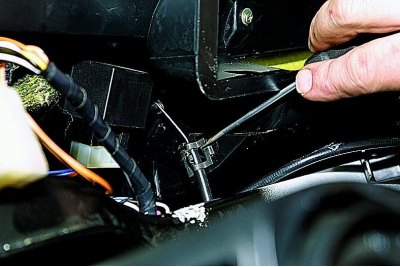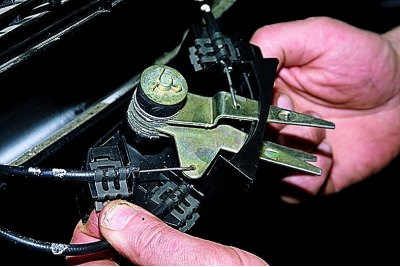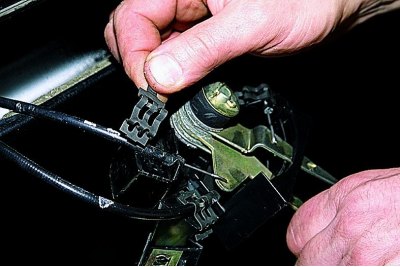
box head «on 10» unscrew the four nuts of the bolts securing the air intake box and the radiator casing,..

... while in the engine compartment, the assistant holds the bolts with a key «on 10».

We take out the bolts.

Remove the airbox.
The connection of the air box to the body is sealed with a sponge rubber gasket glued to the flange of the air box.

In the cabin, lower the radiator shroud.
Removing the radiator shroud is prevented by the flexible air damper control rod.

Using a screwdriver, pry off the clamping bracket of the thrust shell..

... and remove the bracket.

Disconnect the rod from the damper lever.
If necessary, disconnect in the same way..

... draft damper windshield heating.
To remove the bracket for the heater control levers, unscrew the screws securing the bracket to the instrument panel (see Removing the instrument panel) and take the bracket down.

With a finger we pry the clamping bracket of the thrust shell..

...and take it off.

We derive the thrust from the hole of the lever.
Having disconnected all three rods from the bracket of the heater control levers, remove it.
To remove the thrust of the heater tap..

... we bring it out from behind the body of the glove box (dashboard removed for clarity).
We assemble in the reverse order. We ensure the completeness of opening and closing of the dampers and the heater tap, choosing the places for fastening the shells of the rods with brackets.
Helpful Hints
Check of serviceability of a radiator of a heater
It happens that the radiator gives off hot air only for the first few seconds after the heater fan is turned on, and then the air remains barely warm. The malfunction may be caused by the displacement of the rubber partition, which divides the tank into two parts. To check, drain the coolant from the cooling system. We put the radiator removed from the car vertically, with the nozzles down. We connect a hose with water from the water supply to one of the nozzles and slowly start the stream. On a faulty radiator, water will immediately run out of another pipe. A serviceable radiator will fill up, become noticeably heavier, and only then water will flow from another pipe.
